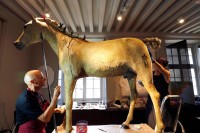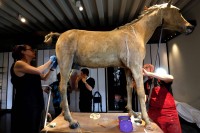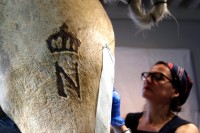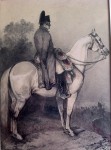 The grey-white Arabian stallion Vizir was born in 1793 in the Ottoman Empire. Sultan Selim III presented the steed to then-First Consul of France Napoleon Bonaparte in 1802, a diplomatic gift marking the peace treaty between the Ottoman Empire and France after three years of war. According to legend, Selim sent the horse to Napoleon with this final wish: “Go, my dear Vizir. Go for Mahomet, go for your Sultan and become Napoleon’s most famous horse.”
The grey-white Arabian stallion Vizir was born in 1793 in the Ottoman Empire. Sultan Selim III presented the steed to then-First Consul of France Napoleon Bonaparte in 1802, a diplomatic gift marking the peace treaty between the Ottoman Empire and France after three years of war. According to legend, Selim sent the horse to Napoleon with this final wish: “Go, my dear Vizir. Go for Mahomet, go for your Sultan and become Napoleon’s most famous horse.”
Napoleon had more than a hundred horses, all of them trained to face battle conditions with steely resolve, and several of them became famous by name for participating in important battles and surviving. (Anywhere from 10 to 20 horses were said to have been shot out from under Napoleon in the heat of battle.) Vizir was painted in equestrian portraits with Napoleon by artists including Baron Gros, Hippolyte Bellangé, Charles Thevenin and Horace Vernet for a Sèvres porcelain series on Napoleon’s horses.
 He wasn’t just a handsome model. Napoleon first rode Vizir into battle in 1805. Bearing the stamp of the imperial stables, a crowned “N” on his left haunch, Vizir carried the emperor in the Battle of Jena on October 14th, 1806, and in many other battles in the Prussian and Polish campaigns. He was not enlisted for duty during Napoleon’s disastrous Russian campaign, lucky for him, or the subsequent ones in Germany and France because as a 20-year-old, he was considered too old for battle.
He wasn’t just a handsome model. Napoleon first rode Vizir into battle in 1805. Bearing the stamp of the imperial stables, a crowned “N” on his left haunch, Vizir carried the emperor in the Battle of Jena on October 14th, 1806, and in many other battles in the Prussian and Polish campaigns. He was not enlisted for duty during Napoleon’s disastrous Russian campaign, lucky for him, or the subsequent ones in Germany and France because as a 20-year-old, he was considered too old for battle.
Vizir was still beloved by the emperor who took him with him to exile on the island of Elba in 1814, and then back to France again during the Hundred Days, although he kept him safe behind the lines. After Napoleon’s final defeat at Waterloo in 1815, Vizir retired and was taken in by Philippe de Chaulaire, a squire of the imperial stables. Vizir died on July 30th, 1826, at the venerable age of 33.
M. de Chaulaire had him taxidermied, but fearing the anti-Napoleonic political climate of the Bourbon Restoration, he sold Vizir to William Clark, an Englishman living in northern France. Clark felt the same political pressure after Louis-Napoleon’s failed coup and in 1839 passed Vizir along to another Englishman, John Greaves. Greaves smuggled the stuffed horse out of France into England by dumping the framing, unstitching his skin and stashing it in his suitcase. Safe in England, Vizir was remounted and put on display at Manchester’s Natural History Museum in 1843.
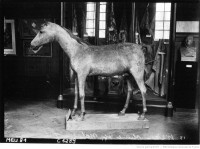 Vizir returned to France in 1868 when the museum, forced to close its doors due to financial problems, gifted him to Louis-Napoleon, now Emperor Napoleon III, during a visit to England. Not knowing what else to do with a large stuffed horse, Napoleon III stored it in the Louvre where it remained in storage for 30 years until it was rediscovered in 1904 and transferred to the newly founded Museum of the Army in 1905. There Vizir would find a permanent home just a few steps from the Invalides where his former master rests eternally.
Vizir returned to France in 1868 when the museum, forced to close its doors due to financial problems, gifted him to Louis-Napoleon, now Emperor Napoleon III, during a visit to England. Not knowing what else to do with a large stuffed horse, Napoleon III stored it in the Louvre where it remained in storage for 30 years until it was rediscovered in 1904 and transferred to the newly founded Museum of the Army in 1905. There Vizir would find a permanent home just a few steps from the Invalides where his former master rests eternally.
Very popular with visitors, Vizir has been on display ever since, but his many posthumous adventures have left him in bad shape. In May, the museum launched a crowdfunding project to give them the wherewithal to restore Vizir, and donors met the goal of 15,000 euro within two weeks. The final amount raised was 20,534 euros ($23,130).
Now Yveline Huguet and Jack Thiney, taxidermists and specialists in the restoration of organic material, are hard at work on Vizir’s sadly degraded hide. They have X-rayed him and are working on a thorough cleaning, rehydrating the hide, filling in several large cracks and restoring the color which has turned a sallow yellowish color over the years, a far cry from the white-gray he was famous for. The project is expected to take about four weeks. Once the restoration is complete, Vizir will be displayed in a new climate-controlled case which will prevent further degradation.
